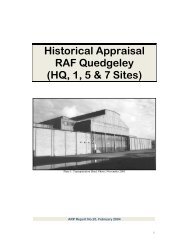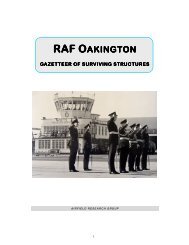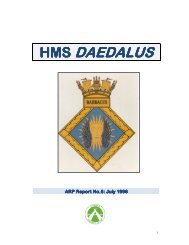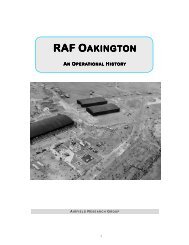RNAS Howden - The Airfield Research Group
RNAS Howden - The Airfield Research Group
RNAS Howden - The Airfield Research Group
You also want an ePaper? Increase the reach of your titles
YUMPU automatically turns print PDFs into web optimized ePapers that Google loves.
Definite patrol areas were laid down for each station and these were extended after April for the stations<br />
at East Fortune and <strong>Howden</strong> whereby they overlapped at the river Tyne. Prior to this, patrols from<br />
<strong>Howden</strong> were generally limited with one airship flying to a position 20 miles due east of Hornsea at 800<br />
feet, then on to a position 20 miles due east of the mouth of the river Tees, and return. Another airship<br />
would be ordered to a position 20 miles due east of Hornsea at 800 feet, then to Sheringham Bank Light,<br />
and return by the same route. Anti-submarine patrols embraced the whole coast of the UK with the<br />
exception of the west coast of Scotland. Patrols were carried out in conjunction with destroyers, airships<br />
using the same radio wave length as the destroyer flotillas.<br />
<strong>The</strong> compliment of airships based at <strong>Howden</strong> at the end of 1917 consisted of the following:<br />
• Rigids Nos. 9 and 25<br />
• Parsevals Nos. 5 and 7<br />
• Coastals Nos. 4, 10, 11 and 21<br />
During the year a total of 2,086 flying hours was carried out. <strong>The</strong> best months being April with 215 hours,<br />
June with 226 hours, and July with 258 hours. <strong>The</strong> weather was generally unsuitable for flying both in the<br />
spring and late autumn.<br />
<strong>The</strong> policy was adopted of sending out on patrol not more than two coastal airships at any one time. This<br />
succeeded in reducing the flying hours but allowed a more efficient patrol to be kept up. It also<br />
maintained engine running down which required less engine changes due to failures. <strong>The</strong> Vickers-built<br />
Parseval ships were mainly employed in training pilots and crews for rigid airship work.<br />
A temporary mooring ground was established at Gosforth Park, near Newcastle and was used by the<br />
Coastal ships which could land there at night at the end of a patrol, and return to <strong>Howden</strong> the following<br />
day. <strong>The</strong> ships were moored out in the open, secured to a landing block or a Jeffrey lorry by the<br />
‘Usborne’ method. A supply of gas and petrol was also stored there. This substation was closed on 1<br />
October 1917 as the soldiers whose services were utilized for landing the airships, had left the district.<br />
Rigid airship No.9 had arrived at <strong>Howden</strong> on 4 April and carried out a number of instructional flights for<br />
officers and crews. Her principal flights throughout the year were as follows:<br />
• During June a patrol over the sea lasting 10 hours<br />
• 26 June – a flight of 12 ¾ hours<br />
• On 21 July there was a flight of 26 ¾ hours covering a distance of 430 miles – a record flight for a<br />
British airship in 1917<br />
• On 6 August the ship carried out a long flight of 24 ¾ hours, landing at East Fortune owing to fog.<br />
Parseval No.4 left for Pulham in March, and in May Parseval No.6 carried out trials, plus a further flight<br />
trial of six hours in the early part of June. Owing to lack of lift, this ship was principally employed in night<br />
flying. On one occasion in July the ship carried out a patrol of 16 hours, and also in the same month<br />
made two special night flights to test local anti-aircraft defences. On 6 August she left for Cranwell to be<br />
stationed there for training purposes.<br />
In April, Coastal C11, while returning from patrol in thick fog, collided with the top of a 500 foot hill near<br />
Scarborough. <strong>The</strong> captain put the ship controls to hard up, but the after-skid struck the hill taking it with<br />
the after engine, engineer’s seat, the engineer himself and all the valve controls. <strong>The</strong> ship then became<br />
1,800 lbs lighter and ascended rapidly until the pressure rose to 85 mm. <strong>The</strong> top patch was pulled off<br />
and the ship descended rapidly from 3,000 feet and was completely smashed.<br />
<strong>The</strong> redesignated Coastal C11a, having been repaired and re-inflated, carried out its initial trials on 19<br />
July and left the station two days later to undergo further trials. After the ship had been in the air for 50<br />
minutes, it became very heavy. Although the ballast was released and the engines were run flat-out with<br />
the elevators hard up, the ship struck the water, being over the river Humber at the time. <strong>The</strong> car was at<br />
once submerged and the envelope came down on the water. After a few seconds the whole ship burst<br />
27






